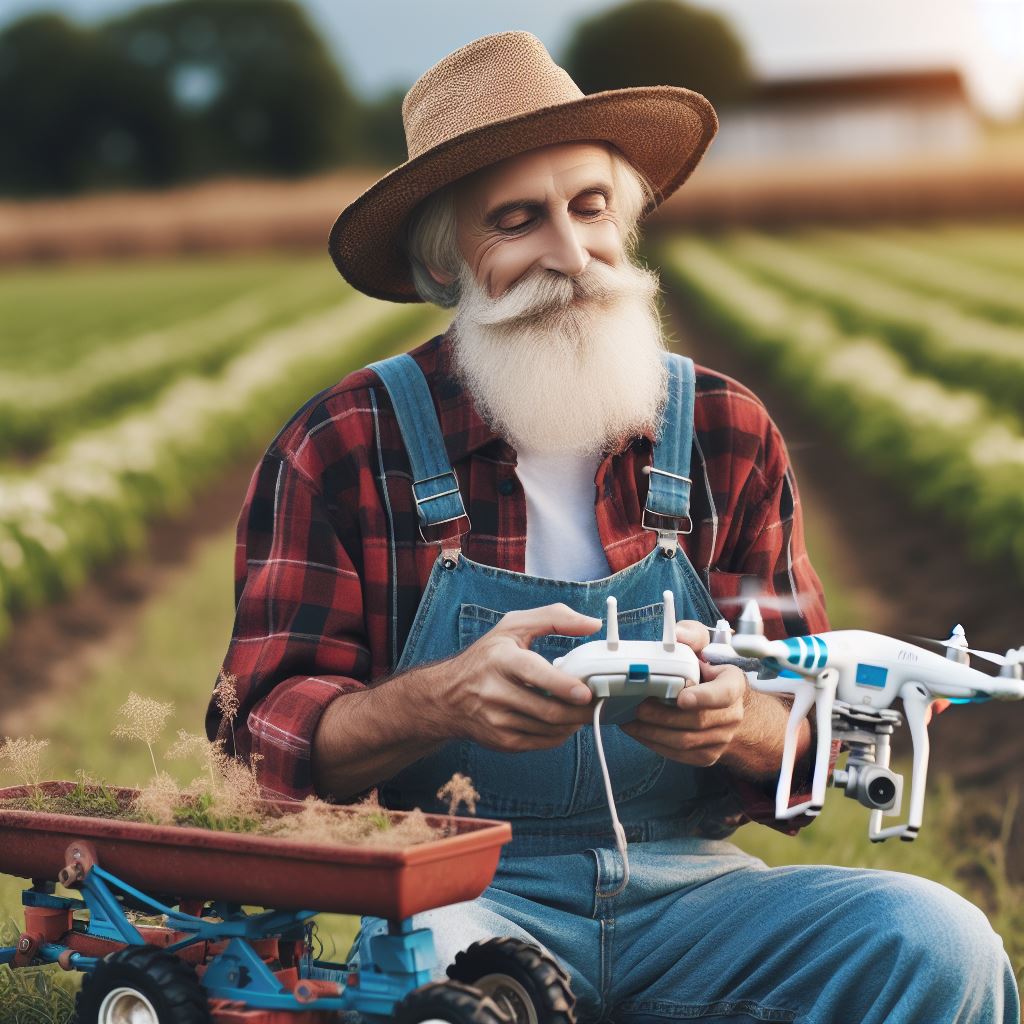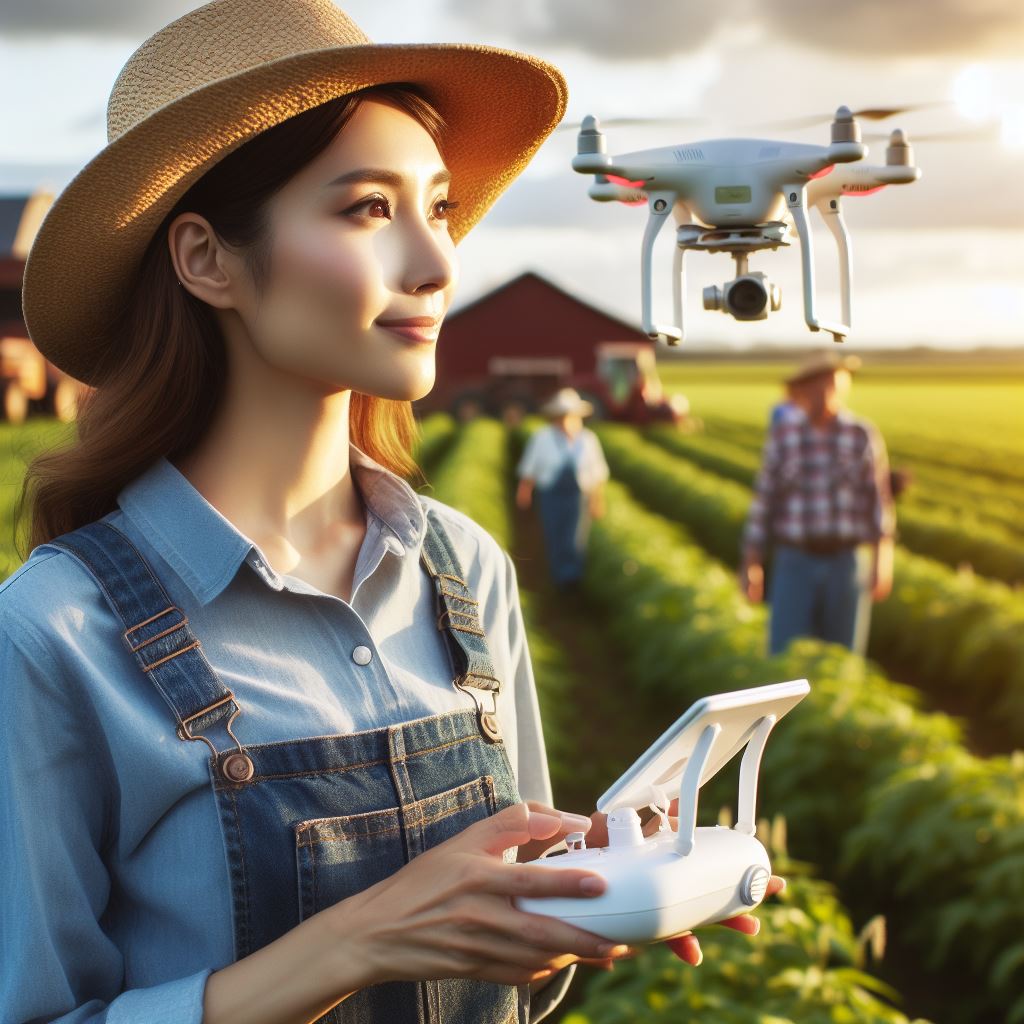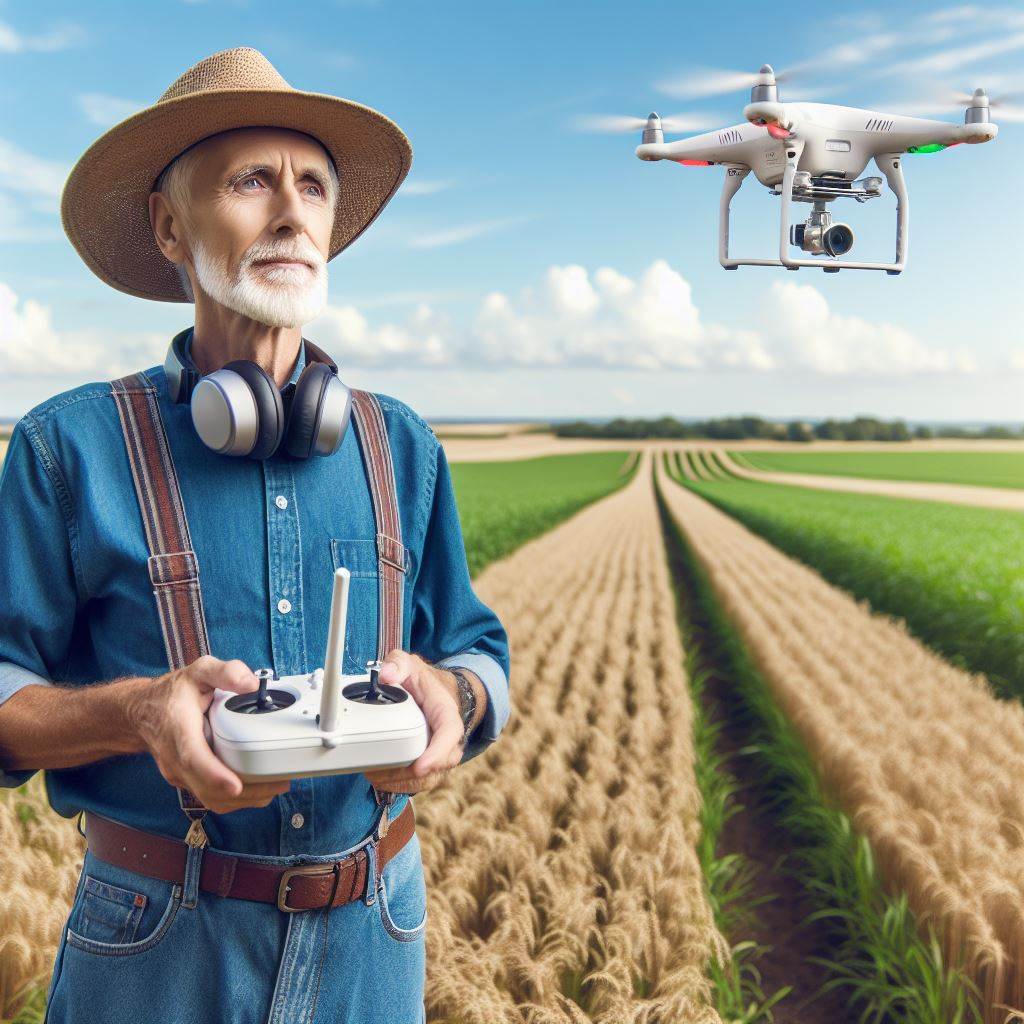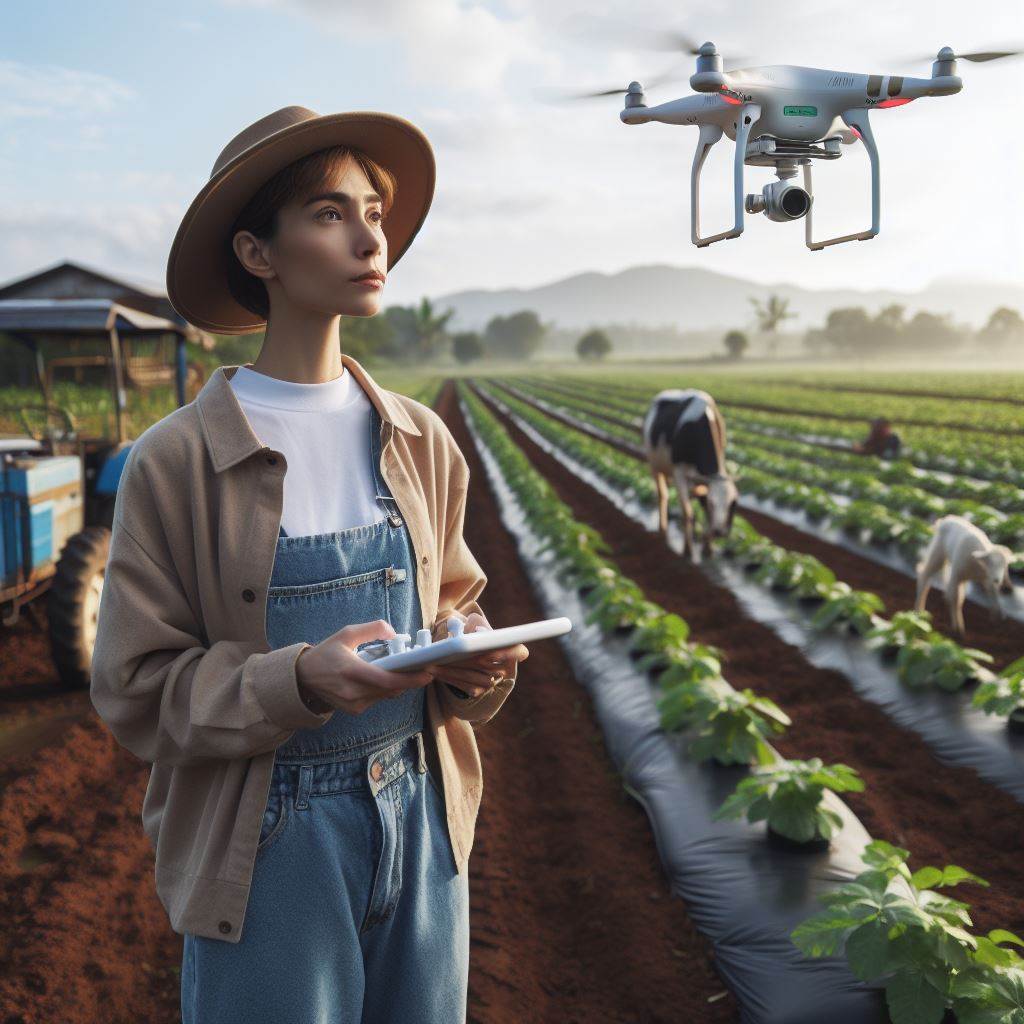Introduction
Agricultural drones are playing a crucial role in modern farming practices, revolutionizing the industry.
Their importance lies in their ability to increase efficiency, reduce costs, and improve crop management.
In this blog post, we will delve into the various aspects of agri drones, from their usage in planting and monitoring crops to their role in harvesting.
Moreover, we will explore the different types of agricultural drones available in the market today, highlighting their features and capabilities.
Additionally, we will discuss the benefits of using agri drones, such as precision farming, yield optimization, and environmental sustainability.
Furthermore, we will examine the challenges that farmers may face when adopting these technological advancements and how to overcome them.
Lastly, we will shed light on the future prospects of agri drones in agriculture, including potential advancements and the impact on farming practices.
Basically, this blog post aims to provide comprehensive information on the importance and potential of agri drones in modern farming.
Stay tuned for an insightful exploration of this cutting-edge technology!
What are agri drones?
Definition and explanation of agri drones
- Agri drones, also known as agricultural drones, are unmanned aerial vehicles (UAVs) specifically designed for agricultural purposes.
- These drones are equipped with various sensors, cameras, and other technologies to perform tasks related to farming.
Types of agri drones available in the market
- Fixed-wing drones: These drones resemble airplanes and are ideal for covering large areas quickly.
- Rotary-wing drones: These drones have multiple rotors and can hover, making them suitable for precision tasks.
- Hybrid drones: These drones combine features of both fixed-wing and rotary-wing drones for enhanced versatility.
Key features and technologies associated with agri drones
- GPS navigation: Agri drones utilize GPS systems to precisely navigate the fields and carry out specific tasks.
- Multispectral imaging: These drones capture images in different wavelengths to analyze plant health and detect problems.
- NDVI (Normalized Difference Vegetation Index): Agri drones use NDVI calculations to assess crop stress and vitality.
- Thermal imaging: By using thermal cameras, agri drones can identify variations in crop temperatures, indicating potential issues.
- Lidar technology: Agri drones equipped with Lidar can create detailed 3D maps of fields, assisting in crop monitoring.
- Automated spraying: Some agri drones have built-in tanks and spray nozzles for automated pesticide and fertilizer application.
- Real-time data transmission: Agri drones collect data during flights and transmit it in real-time to farmers, enabling quick decision-making.
- Precision seed planting: Agri drones can accurately drop seeds at designated locations, optimizing planting efficiency.
- Crop monitoring: With high-resolution cameras, agri drones monitor crop growth, detect diseases, and assess yield potential.
- Livestock management: Agri drones aid in monitoring livestock by providing aerial views and tracking their movement.
Generally, agri drones are advanced technological tools used in agriculture for various tasks such as crop monitoring, seed planting, and livestock management.
These drones possess features like GPS navigation, thermal imaging, and real-time data transmission, making them invaluable for modern farming.
With ongoing advancements, agri drones have the potential to revolutionize the agricultural industry, increasing efficiency and productivity while reducing costs and environmental impact.
Read: Drones in Agri: Boosting Crop Efficiency
Agri drones in planting
Benefits of using agri drones in the planting process
- Increased efficiency: Agri drones can cover large areas of land quickly and accurately, reducing manual labor and saving time.
- Enhanced productivity: With agri drones, farmers can plant seeds at a faster rate, leading to increased crop production.
- Improved crop yield: Agri drones ensure precise seed placement, optimizing seed-to-soil contact, resulting in better germination and higher crop yields.
- Cost savings: By eliminating the need for manual labor and reducing seed wastage, agri drones can help farmers save money in the long run.
- Environmental friendliness: Agri drones help reduce the use of chemicals and fertilizers, promoting sustainable farming practices and minimizing environmental impact.
Seed delivery and accuracy with agri drones
- Precise seed deployment: Agri drones utilize advanced GPS technology to precisely drop seeds at predetermined locations, ensuring optimal spacing and uniform plant distribution.
- Variable rate seeding: Agri drones can adjust seed delivery rates based on soil conditions and crop requirements, maximizing seed performance and minimizing wastage.
- Autonomous operation: Agri drones can be programmed to follow predefined routes, ensuring consistent seed delivery and reducing human error.
- Real-time monitoring: With the help of onboard cameras and sensors, agri drones can capture and analyze data on planting quality, ensuring accurate seed placement.
Efficient use of resources during planting
- Water conservation: Agri drones equipped with infrared sensors can detect areas of water stress in plants, allowing farmers to target irrigation efforts more efficiently.
- Optimized fertilizer application: Agri drones can accurately spray fertilizers, reducing nutrient loss and minimizing environmental contamination.
- Weed and pest control: Agri drones can identify and target specific weeds or pests, reducing the need for widespread pesticide application and minimizing chemical exposure.
- Soil analysis: Agri drones can collect soil samples and analyze nutrient levels, enabling farmers to make data-driven decisions for fertilization and soil amendments.
Case studies and real-life examples of agri drones in planting
- Case study: In Australia, a farmer used agri drones for precision planting, resulting in a 15% increase in crop yield and significant cost savings.
- Real-life example: The Japanese government funded a project where agri drones were used to plant trees on deforested lands, restoring the ecosystem efficiently and effectively.
- Success story: A strawberry farmer in California implemented agri drones for planting, resulting in better plant growth, reduced labor costs, and increased profitability.
- Research findings: Studies conducted in Europe demonstrated that agri drones improved planting efficiency by 80% compared to traditional methods.
Essentially, agri drones have revolutionized the planting process in agriculture.
Their benefits, such as increased efficiency, improved crop yield, and cost savings, make them invaluable tools for farmers.
Transform Your Agribusiness
Unlock your farm's potential with expert advice tailored to your needs. Get actionable steps that drive real results.
Get StartedBy utilizing advanced technologies and data-driven decision-making, agri drones optimize seed delivery, conserve resources, and minimize environmental impact.
Real-life examples and case studies further demonstrate the positive impact of agri drones in planting.
As the agricultural industry continues to evolve, agri drones will play an increasingly vital role in ensuring sustainable and productive farming practices.
Read: Drones: Transforming Agricultural Practices
Agri drones in crop monitoring
Importance of crop monitoring for farmers
- Crop monitoring is crucial for farmers to assess the health and growth of their crops.
- It helps them detect any signs of plant diseases, pests, or nutrient deficiencies.
- By monitoring their crops, farmers can make timely decisions and take necessary actions to protect their yields.
How agri drones aid in crop monitoring
- Agri drones provide a cost-effective and efficient way to monitor large agricultural fields.
- With their aerial capabilities, they can cover extensive areas quickly and capture high-resolution images.
- These images provide valuable information about crop health, growth patterns, and potential issues.
Use of sensors and imaging technology for crop assessment
- Agri drones are equipped with various sensors and imaging technology to assess crops accurately.
- Multispectral cameras capture images in different wavelengths, allowing farmers to analyze plant health.
- Thermal cameras detect temperature variations, helping identify areas of stress or water deficiency in crops.
- Light detection and ranging (LiDAR) technology measures plant height and canopy density, aiding in yield estimation.
Benefits of timely and accurate crop monitoring using agri drones
- Early detection of crop diseases and pests enables farmers to take immediate action and prevent further damage.
- By identifying nutrient deficiencies, farmers can adjust fertilization plans to optimize crop growth.
- Timely monitoring helps farmers minimize crop loss, increase yields, and improve overall farm efficiency.
- Agri drones provide real-time data, allowing farmers to make informed decisions quickly.
- The use of drones reduces the need for manual labor and saves time and resources for farmers.
In general, agri drones play a vital role in crop monitoring for farmers.
The ability to efficiently assess crop health, detect diseases, pests, and nutrient deficiencies is crucial for maximizing yields and ensuring farm profitability.
With the use of sensors and imaging technology, agri drones provide accurate and timely information for making informed decisions.
By embracing this technology, farmers can effectively mitigate potential crop risks, optimize resource allocation, and enhance overall farm management practices.
Read: Farm Drones: Revolutionizing Crop Management
Agri drones in crop management
Pest and disease detection using agri drones
Agri drones equipped with advanced imaging sensors can help identify pests and diseases in crops.
They can capture high-resolution images and provide real-time data for early detection and targeted treatment.
This enables farmers to take immediate action, preventing the spread of pests and diseases and minimizing crop losses.
Crop spraying and precision agriculture with drones
Agri drones have revolutionized crop spraying by providing precise and efficient application of pesticides, fertilizers, and herbicides.
With their ability to navigate through difficult terrains and reach inaccessible areas, drones ensure comprehensive coverage of the entire crop field.
This not only reduces manual labor but also minimizes environmental impact by using resources more efficiently.
Role of agri drones in irrigation and water management
Agri drones equipped with infrared and thermal sensors can analyze the moisture content of soil and assess crop water requirements.
They can generate detailed maps indicating areas of water stress, enabling farmers to optimize irrigation practices and conserve water.
By providing real-time data on soil moisture levels, agri drones help prevent over or under-watering, leading to increased crop productivity.
Increased efficiency and reduced costs with agri drones in crop management
The use of agri drones in crop management significantly increases efficiency and reduces costs for farmers.
Drones can cover large areas in a short time, allowing farmers to monitor and manage crops more effectively.
Additionally, drones reduce the need for manual labor, saving time and expenses associated with traditional methods of crop management.
Overall, agri drones offer a cost-effective solution that improves crop yields and maximizes profits for farmers.
Read: Aerial Farming: Drones as Key Tools

Agri drones in harvesting
Harvesting is a crucial stage in agricultural production that determines the success of a farmer’s efforts.
Showcase Your Farming Business
Publish your professional farming services profile on our blog for a one-time fee of $200 and reach a dedicated audience of farmers and agribusiness owners.
Publish Your ProfileIt involves careful planning and execution to ensure maximum yield and minimal loss.
Agri drones have emerged as valuable tools in making the harvesting process more efficient and productive.
Importance of efficient harvesting techniques
- Efficient harvesting techniques are necessary to minimize crop damage and maximize yield.
- Traditional methods of harvesting are often time-consuming and labor-intensive.
- Improper harvesting techniques can lead to post-harvest losses and reduced overall profitability.
- Using advanced technologies like agri drones can significantly improve harvesting efficiency.
How agri drones enhance the harvesting process
- Agri drones equipped with sensors can provide real-time data on crop maturity and conditions.
- This data enables farmers to identify the optimal time for harvesting, ensuring maximum yield and quality.
- The drones can also be programmed to autonomously navigate through fields, scanning crops for maturity.
- They can identify diseased or damaged crops, allowing farmers to selectively harvest and reduce waste.
- Agri drones equipped with robotic arms or attachments can perform precise cutting and picking of crops.
- This eliminates the need for manual labor and reduces the risk of crop damage.
Yield estimation and optimization with agri drones
- Accurate yield estimation is essential for effective farm management and decision-making.
- Agri drones can capture high-resolution images and create detailed crop maps for yield estimation.
- These maps can highlight variations in crop growth and help farmers identify areas of low productivity.
- Based on this information, farmers can optimize resources and make informed decisions on harvesting strategies.
Benefits of using agri drones in post-harvest activities
- Agri drones are not only beneficial during the harvesting process but also in post-harvest activities.
- They can be used to transport harvested crops quickly and efficiently from the fields to storage facilities.
- This reduces the time between harvesting and processing, preserving the freshness and quality of the crops.
- Drones can also monitor stored crops for signs of spoilage or infestation, enabling timely interventions.
- By minimizing post-harvest losses, agri drones contribute to increased profitability for farmers.
In essence, agri drones have revolutionized the agricultural industry, particularly in the harvesting process.
Their ability to provide real-time data, precision cutting, and yield estimation has significantly improved efficiency.
Furthermore, their role in post-harvest activities ensures the preservation of crop quality and minimized losses.
As technology continues to advance, agri drones are expected to play an even more critical role in future farming practices.
Read: Crop Health: Drones Leading the Way
Challenges and Limitations of Agri Drones
Regulatory and Legal Issues Surrounding Agri Drones
- Regulatory frameworks for agri drones vary across different countries and regions.
- Obtaining necessary permits and licenses can be a time-consuming and complex process.
- Restrictions on flight altitude, flying near people, and privacy protection can limit agri drone operations.
- Insurance requirements and liability concerns may pose additional challenges for agri drone operators.
Initial Investment and Affordability Considerations
- The initial cost of purchasing agri drones and related equipment can be high.
- Ongoing maintenance and repairs can also add to the overall expenses.
- For small-scale farmers with limited resources, the affordability of agri drones can be a significant barrier.
- Access to financing options and subsidies can help alleviate the financial burden.
Training and Skill Requirements for Operating Agri Drones
- Proper training is essential to ensure safe and effective operation of agri drones.
- Operators must acquire knowledge of drone functionalities, flight planning, and data analysis.
- Familiarity with agricultural practices and crop monitoring techniques is necessary for accurate decision-making.
- Continuous skill development and staying updated with technological advancements are crucial.
Potential Risks and Privacy Concerns Related to Agri Drones
- Agri drones can potentially cause accidents or property damage if not operated correctly.
- Privacy concerns arise from the ability of drones to capture aerial images and collect sensitive data.
- Unauthorized access to data, such as crop yields or field conditions, could pose a threat to farmers’ competitiveness.
- Implementing strict data protection measures and ensuring data ownership and control are critical to addressing privacy concerns.
Overcoming these challenges and limitations
Overcoming these challenges and limitations is crucial for the widespread adoption and successful integration of agri drones in the agricultural sector.
Governments and regulatory bodies need to establish clear and consistent regulations that balance the benefits and risks associated with agri drone usage.
Simplifying the permit application process and providing guidance on compliance can facilitate the legal operation of agri drones.
Addressing affordability concerns
To address affordability concerns, governments and agricultural associations can offer financial support programs, grants, or subsidies specifically targeted towards enabling small-scale farmers to invest in agri drones.
Collaborations with technology companies and manufacturers can lead to the development of cost-effective drone solutions suitable for small and medium-sized farms.
Training and skill requirements
In terms of training and skill requirements, agricultural universities and organizations can offer structured courses on agri drone operations and management.
These programs should cover both technical aspects and the application of data-driven decision-making in agriculture.
Creating partnerships with drone training institutes can also help ensure standardized training and certification for agri drone operators.
Mitigating risks and privacy concerns
To mitigate risks and privacy concerns, strict regulations regarding flight restrictions, data collection, and storage should be implemented.
Drone manufacturers can enhance safety features and introduce geofencing technology to prevent unauthorized flying in restricted areas.
Farmers must also be educated on the importance of implementing secure data storage and transmission practices to protect sensitive information.
In short, while agri drones offer immense potential in revolutionizing agriculture, various challenges and limitations need to be addressed.
Regulatory issues, investment considerations, training requirements, and privacy concerns require robust solutions for the widespread and responsible adoption of these technologies.
Collaborative efforts between governments, agricultural organizations, technology companies, and farmers can help overcome these challenges and unlock the full benefits of agri drones in the future of farming.
Future prospects of agri drones
Advancements in agri drone technology and its impact
- Continuous advancements in agri drone technology are set to revolutionize the agriculture industry.
- Improved sensors and imaging capabilities allow for better crop monitoring and yield estimation.
- High-resolution cameras and thermal sensors enable early detection of pests, diseases, and irrigation issues.
- Real-time data collection and analysis help farmers make informed decisions and optimize their crop management practices.
- Enhanced precision and accuracy lead to reduced resource wastage and increased overall productivity.
- Agri drones can cover large areas quickly, reducing the time and cost associated with manual inspections.
- The impact of these advancements is significant, as they contribute to increased efficiency and profitability in farming.
Potential benefits and opportunities for farmers
- Agri drones offer farmers a range of potential benefits and opportunities.
- Improved crop monitoring allows for early intervention, reducing crop losses and increasing yields.
- Precision application of fertilizers and pesticides ensures optimal use, reducing environmental impact and costs.
- Drones can access hard-to-reach areas, such as steep terrains or dense vegetation, improving crop inspection and management.
- Real-time data on soil moisture levels and nutrient content enable precise irrigation and fertilization.
- Automation of tasks like crop scouting and spraying reduces labor requirements and frees up time for other important activities.
- Integration of agri drones with other technologies, such as AI and machine learning, opens up possibilities for further optimization and decision-making.
Role of agri drones in sustainable farming practices
- Agri drones play a crucial role in promoting sustainable farming practices.
- By enabling targeted interventions, they minimize the use of agrochemicals, reducing environmental pollution.
- Precise irrigation and fertilization techniques promoted by drones prevent overuse and conserve water resources.
- Early detection of crop diseases and pests allows for timely actions, reducing the need for extensive pesticide applications.
- Drones facilitate the adoption of precision farming methods, which optimize resource utilization and minimize waste.
- The ability to map and monitor large areas helps in the identification of erosion-prone zones and implementation of erosion control measures.
- Overall, agri drones contribute to the long-term sustainability of farming by promoting responsible practices and reducing negative environmental impacts.
Predicted growth and adoption of agri drones in the future
- The future looks promising for the growth and adoption of agri drones in the agriculture sector.
- Technological advancements will continue to enhance the capabilities and affordability of agri drones.
- Reduced costs, improved battery life, and increased flight ranges will make drones more accessible to farmers.
- Increased awareness of the benefits and proven results will drive greater acceptance and adoption of agri drones.
- Government support and favorable regulations will further encourage farmers to embrace this technology.
- Collaboration between drone manufacturers, farmers, and researchers will lead to tailor-made solutions for specific farming needs.
- The predicted growth of agri drone adoption signifies a transformative shift in the way farming is done, enabling farmers to achieve higher yields, better profitability, and sustainable practices.
The future of agri drones is filled with immense possibilities.
With advancements in technology, farmers will continue to benefit from the improved capabilities and cost-effectiveness of agri drones.
These aerial tools will play a vital role in sustainable farming practices, enabling targeted interventions, reducing resource wastage, and promoting responsible farming.
The predicted growth and adoption of agri drones highlight the importance of this technology in revolutionizing the agriculture industry and improving overall productivity.
You Might Also Like: Solar Power in Farms: A Green Revolution
Conclusion
Recap of the key points discussed
In this blog post, we explored the various applications of agri drones in the agricultural industry.
We discussed how these drones are revolutionizing farming practices, from planting to harvesting.
We examined their ability to perform tasks such as soil analysis, seed planting, crop spraying, and yield monitoring.
Agri drones have proven to be highly efficient, cost-effective, and time-saving tools for farmers.
Implications of agri drones in modern agriculture
The integration of agri drones in modern agriculture has numerous implications.
It allows for precise and targeted application of fertilizers and pesticides, reducing environmental impact.
It provides detailed data on crop health and growth, enabling farmers to make informed decisions about irrigation and crop management.
Agri drones also reduce labor costs and increase productivity, ultimately improving overall farm profitability.
Encouragement for further research and exploration of agri drones
The potential of agri drones is vast, and there is still much to be discovered and explored.
Further research is needed to optimize drone technology and develop advanced features.
This includes improving flight stability, battery life, payload capacity, and incorporating artificial intelligence for autonomous decision-making.
The collaboration between scientists, engineers, and farmers is crucial to unlock the full potential of agri drones and continue advancing agricultural practices.
In a nutshell, agri drones have emerged as a game-changer in modern agriculture.
They offer innovative solutions to longstanding challenges faced by farmers.
Showcase Your Farming Business
Publish your professional farming services profile on our blog for a one-time fee of $200 and reach a dedicated audience of farmers and agribusiness owners.
Publish Your ProfileThe benefits of using agri drones are undeniable, and their widespread adoption can lead to increased productivity, efficient resource utilization, and sustainable farming practices.
As technology continues to evolve, the future of agriculture undoubtedly lies in the skies with agri drones.




